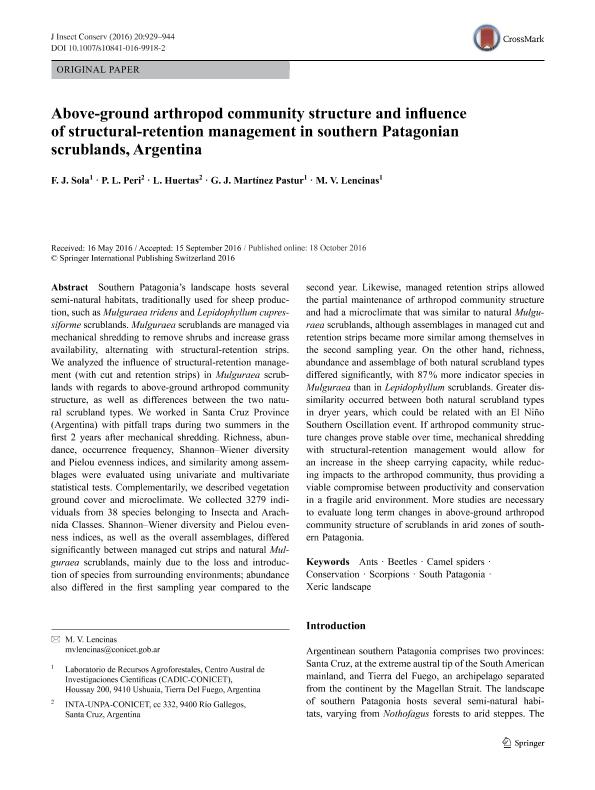Mostrar el registro sencillo del ítem
dc.contributor.author
Sola, Francisco Javier

dc.contributor.author
Peri, Pablo Luis

dc.contributor.author
Huertas, Laura Eugenia

dc.contributor.author
Martínez Pastur, Guillermo José

dc.contributor.author
Lencinas, María Vanessa

dc.date.available
2018-04-06T00:08:36Z
dc.date.issued
2016-12
dc.identifier.citation
Sola, Francisco Javier; Peri, Pablo Luis; Huertas, Laura Eugenia; Martínez Pastur, Guillermo José; Lencinas, María Vanessa; Above-ground arthropod community structure and influence of structural-retention management in southern Patagonian scrublands, Argentina; Springer; Journal of Insect Conservation; 20; 6; 12-2016; 929-944
dc.identifier.issn
1366-638X
dc.identifier.uri
http://hdl.handle.net/11336/41041
dc.description.abstract
The landscape of South Patagonia hosts several semi-natural environments traditionally used for sheep production, such as Mulguraea tridens and Lepidophyllum cupressiforme scrublands, which are managed by removal to increase grass availability, alternating with structural-retention strips. We analyzed the influence of structural-retention management (with cut areas and retention strips) in Mulguraea scrublands on above-ground arthropod assemblages, as well as differences between the two scrubland types in natural conditions and the effect of climatic variations caused by El Niño Southern Oscillation (ENSO) event. We worked in Santa Cruz province (Argentina) with pitfall traps during two summers, and evaluated richness, abundance, occurrence frequency, Shannon-Wiener diversity and Pielou evenness indices, and assemblage using univariate and multivariate tests. Complementarily, we described vegetation, floor cover and microclimate. We collected 3279 individuals of 38 species belonging to Classes Insecta and Arachnida. Diversity in Mulguraea cut areas statistically differed from those at natural conditions, mainly by loss and introduction of species from surrounding environments. While retention strips allows partially maintaining microclimate and legacies of the natural scrubland. On the other hand, assemblages of both natural scrubland types differed in richness and composition, with 87% more indicator species in Mulguraea than in Lepidophyllum scrubland. Greater dissimilarity occurred between both scrubland types in dryer years (with positive Multivariate ENSO Index). If arthropod diversity changes prove stable over time, this technique would allow for an increase in loading capacity for sheep production while reducing impacts on the arthropod community, thus providing a viable compromise between productivity and conservation in a fragile arid environment. Undoubtedly, some completely uncut areas would need to be maintained in proximity to provide reservoirs of scrubland specific species (Mazía et al., 2006). Further follow-up sampling will be required to determine the outcome of this experimental manipulation. More studies are necessary to evaluate long term changes in above-ground arthropod diversity of scrublands in arid zones of South Patagonia.
dc.format
application/pdf
dc.language.iso
eng
dc.publisher
Springer

dc.rights
info:eu-repo/semantics/openAccess
dc.rights.uri
https://creativecommons.org/licenses/by-nc-sa/2.5/ar/
dc.subject
Beetles
dc.subject
Ants
dc.subject
Camel Spiders
dc.subject
Scorpions
dc.subject
Conservation
dc.subject
Xeric Landscape
dc.subject
South Patagonia
dc.subject.classification
Agricultura

dc.subject.classification
Agricultura, Silvicultura y Pesca

dc.subject.classification
CIENCIAS AGRÍCOLAS

dc.title
Above-ground arthropod community structure and influence of structural-retention management in southern Patagonian scrublands, Argentina
dc.type
info:eu-repo/semantics/article
dc.type
info:ar-repo/semantics/artículo
dc.type
info:eu-repo/semantics/publishedVersion
dc.date.updated
2018-04-03T18:26:09Z
dc.journal.volume
20
dc.journal.number
6
dc.journal.pagination
929-944
dc.journal.pais
Alemania

dc.journal.ciudad
Berlín
dc.description.fil
Fil: Sola, Francisco Javier. Consejo Nacional de Investigaciones Científicas y Técnicas. Centro Austral de Investigaciones Científicas; Argentina
dc.description.fil
Fil: Peri, Pablo Luis. Universidad Nacional de la Patagonia Austral; Argentina. Consejo Nacional de Investigaciones Científicas y Técnicas; Argentina. Instituto Nacional de Tecnología Agropecuaria; Argentina
dc.description.fil
Fil: Huertas, Laura Eugenia. Consejo Nacional de Investigaciones Científicas y Técnicas; Argentina. Instituto Nacional de Tecnología Agropecuaria; Argentina. Universidad Nacional de la Patagonia Austral; Argentina
dc.description.fil
Fil: Martínez Pastur, Guillermo José. Consejo Nacional de Investigaciones Científicas y Técnicas. Centro Austral de Investigaciones Científicas; Argentina
dc.description.fil
Fil: Lencinas, María Vanessa. Consejo Nacional de Investigaciones Científicas y Técnicas. Centro Austral de Investigaciones Científicas; Argentina
dc.journal.title
Journal of Insect Conservation

dc.relation.alternativeid
info:eu-repo/semantics/altIdentifier/doi/http://dx.doi.org/10.1007/s10841-016-9918-2
dc.relation.alternativeid
info:eu-repo/semantics/altIdentifier/url/https://link.springer.com/article/10.1007/s10841-016-9918-2
Archivos asociados
